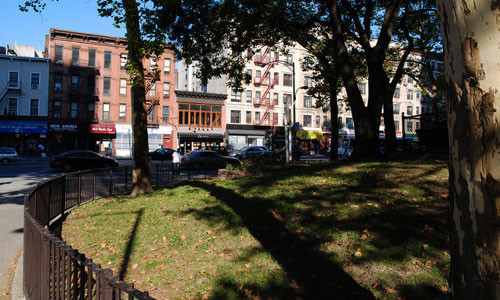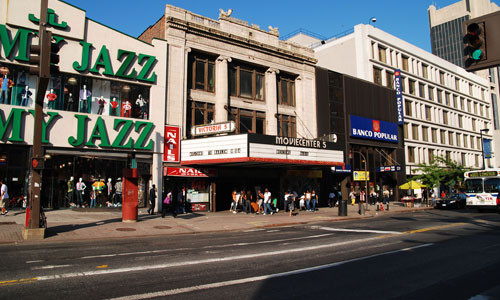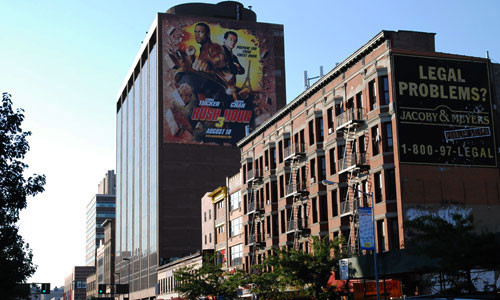125th Street in Harlem stands as a vibrant testament to New York City’s dynamic urban landscape, embodying a rich tapestry of African American culture, historical significance, and architectural diversity. This iconic thoroughfare is more than just a street; it’s a cultural epicenter and a vital transportation artery that has shaped the identity of Harlem for over a century. Recognized by the American Planning Association as one of the 10 Great Streets in America, Manhattan’s 125th Street has successfully navigated periods of significant demographic shifts, infrastructural challenges, economic fluctuations, and urban development, all while preserving its unique and powerful character.
 General Grant Houses at 125th Street and Amsterdam Avenue in Manhattan
General Grant Houses at 125th Street and Amsterdam Avenue in Manhattan
A Masterplan and Key Transportation Hub
Part of the comprehensive Commissioner’s Plan of 1811, 125th Street is strategically positioned as one of fifteen crucial crosstown streets in Manhattan. What sets it apart is its exceptional connectivity to New York City’s major transportation networks. Spanning from the Hudson River to the East River, it seamlessly links the Henry Hudson Parkway, the FDR Drive, and the Triborough Bridge. This accessibility is further enhanced by numerous subway and bus lines, making 125th Street a pivotal transportation hub within Manhattan and beyond, ensuring its constant flow of activity and people.
Architectural Mosaic Reflecting Time and Culture
The architectural landscape of 125th Street is a captivating blend of styles, reflecting its long and evolving history. From early single-family brownstones and classic tenement apartments to spacious warehouses, the street showcases a diverse range of building types. Art deco commercial buildings, early 20th-century office structures, and mid-century modern designs all contribute to its unique visual character. Notably, the predominantly low-rise buildings foster an open and inviting atmosphere, differentiating it from the skyscraper-dominated canyons of other Manhattan avenues, and enhancing its pedestrian-friendly appeal.
 Historic Victoria Theater on Manhattan's 125th Street
Historic Victoria Theater on Manhattan's 125th Street
Harlem Renaissance and Cultural Flourishing
The Harlem Renaissance of the 1920s and 1930s marked a transformative era for 125th Street, as it became a focal point for an influx of African American residents and a flourishing of rich cultural traditions. At the heart of this cultural explosion was the world-famous Apollo Theater, a legendary venue on 125th Street that played a pivotal role in launching the careers of iconic black entertainers. Luminaries such as Billie Holiday, Ella Fitzgerald, James Brown, Stevie Wonder, and Aretha Franklin graced its stage, solidifying the Apollo and 125th Street’s place in music history and African American cultural heritage.
Navigating Post-War Challenges and Urban Renewal
Following World War II, 125th Street, like many urban areas across the United States, faced periods of decline. The Federal Housing Act contributed to urban renewal initiatives and “slum” redevelopment, which, while intended to modernize cities, sometimes disrupted existing communities. While some “superblock” housing projects were constructed along 125th Street, broader urban renewal projects in the vicinity led to the demolition of historic Harlem housing and inadvertently fueled disinvestment in the area, presenting new challenges for the street and its community.
Revitalization and a Vision for the Future
Today, 125th Street is experiencing a significant resurgence, prompting a comprehensive re-evaluation of “Harlem’s Main Street.” The focus is on further cultivating its identity as a vital regional business hub and a premier destination for culture, arts, and entertainment. According to Edwin Marshall of the New York City Department of City Planning, ongoing development aims to enhance its role in the city’s cultural and economic landscape.
Preserving the street’s historical importance as a community-centered and pedestrian-oriented space is crucial to this revitalization. Complementing updated city zoning regulations, the 125th Street Business Improvement District is advocating for enhanced street lighting and lampposts. Furthermore, the Harlem Community Development Corporation is collaborating with the New York State Office of General Services to redesign the plaza in front of the Adam Clayton Powell, Jr. State Office Building, planning to incorporate trees for shade and a more welcoming environment. The plaza already hosts a popular farmer’s market during the summer, bringing fresh, regional produce directly to the heart of 125th Street.
 125th Street Streetscape between 5th and Lenox Avenues in Manhattan
125th Street Streetscape between 5th and Lenox Avenues in Manhattan
Future developments on 125th Street are deeply informed by community priorities, aiming to shape both the physical and social environment into an even more walkable, livable, and vibrant commercial space. This ongoing evolution ensures that Manhattan’s 125th Street will not only maintain but amplify its long-standing reputation as a truly great street, recognized for its cultural richness, historical depth, and enduring community spirit.
